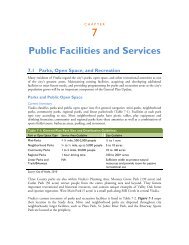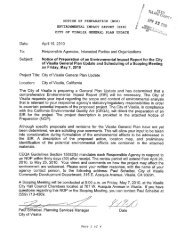General Plan Update Review Committee Draft Elements Part 2 For ...
General Plan Update Review Committee Draft Elements Part 2 For ...
General Plan Update Review Committee Draft Elements Part 2 For ...
You also want an ePaper? Increase the reach of your titles
YUMPU automatically turns print PDFs into web optimized ePapers that Google loves.
6-12 VISALIA GENERAL PLAN UPDATE<br />
In 2010, farmland, as defined by the State soil categories,<br />
accounted for approximately 67 percent of the<br />
<strong>Plan</strong>ning Area. The remaining 33 percent of the <strong>Plan</strong>ning<br />
Area is designated as either urban and built-up,<br />
vacant or disturbed land, water resources, or other<br />
types of soils. As shown in Figure 6-4, the majority<br />
of land encircling the urbanized area of Visalia is categorized<br />
as Prime Farmland, which makes up three<br />
quarters of the <strong>Plan</strong>ning Area’s farmland. To the far<br />
northwest there is a band of land classified as Farmland<br />
of Statewide Importance.<br />
Williamson Act<br />
The California Land Conservation Act, commonly<br />
referred to as the Williamson Act, was enacted in 1965<br />
to preserve agricultural and open space land in danger<br />
of premature conversion to urban uses. Its success has<br />
been based on the dual incentives of lowered property<br />
taxes for individual landowners and payments of<br />
subventions to counties for some of the losses of property<br />
tax revenues. Under the Open Space Subvention<br />
Act of 1971, the State has provided annual subvention<br />
payments to counties for foregone property tax revenue<br />
due to Williamson Act contracts. State payments<br />
have been reduced in recent years.<br />
As of 2010, 58 percent of the total agricultural acreage<br />
in the <strong>Plan</strong>ning Area (25,724 acres) were under<br />
Williamson Act contracts. Of these, 2,417 acres are in<br />
non-renewal, meaning that at the end of their 10-year<br />
period, they will not renew their contracts. Figure<br />
6-4 indicates which parcels are under contract and<br />
which are not renewing.<br />
Farmland Protection Issues<br />
Significant agricultural land area within the Visalia<br />
<strong>Plan</strong>ning Area is likely to be converted to urban uses<br />
by 2030 in order to accommodate projected growth.<br />
At buildout, 55 percent of the <strong>Plan</strong>ning Area will be<br />
either urban, water resources or other soil types, compared<br />
with 33 percent in 2010, while 45 percent will<br />
be in agricultural use, down from 67 percent today.<br />
If the <strong>General</strong> <strong>Plan</strong> were developed to its full capacity,<br />
about 14,580 acres of agricultural land would<br />
be replaced by urban development. Land classified<br />
as “Prime Farmland” and “Farmland of Statewide<br />
Importance” account for 89 percent of this land, or<br />
12,490 and 399 acres, respectively. Farmland soils<br />
now and at buildout are summarized in Table 6-1.<br />
Continued conversion of agricultural lands to urban<br />
uses and rural residential uses could have an impact<br />
on the County’s agricultural economic base. To protect<br />
farm land and open space, the Land Use Element<br />
establishes a fairly compact urban area, encouraging<br />
infill development and new growth adjacent to<br />
or near existing urban uses, thus minimizing sprawl<br />
and unnecessary conversion of agricultural lands.<br />
Much of the farmland that is expected to be urbanized<br />
over the next 20 years was designated for development<br />
under the previous <strong>General</strong> <strong>Plan</strong>. In fact, at<br />
32,650 acres the total future urbanized area under the<br />
<strong>General</strong> <strong>Plan</strong> is slightly smaller than under the previous<br />
<strong>Plan</strong> while accommodating population growth to<br />
2030.




